- Learning time
- 60 minutes
- First play time
- 180 minutes
Kemet: Blood and Sand
Designed by: Guillaume Montiage,Jacques Bariot
Kemet: Blood and Sand is a territorial battle where players score points for combat – winning! – but also in other ways, such as controlling specific territories, or getting fruitful powers to speed your progress.
Based on an older game (Kemet, with no blood or sand in the title) Blood and Sand follows a similar path. During each round there’s a daylight phase and a night phase: during the day, everyone takes 5 actions, which you hope will carve a path to victory. You can get more troops out on the board, get power tiles, raise pyramids, move troops (potentially triggering battle if you encounter opponents) or pray. Why prayer? Because prayer points are a kind of economy, paying for the raising of pyramids and the purchase of power tiles. Why raise pyramids? Because then the power tiles you get will be more powerful! (You also score a point for a completed pyramid: they have four levels).
Kemet’s heart is beating fast: the game is essentially a punch-up in the desert, where some points you score (eg winning a battle) can’t be taken from you, whereas others (eg controlling a territory) can. The geography of the board is claustrophobic, and it’s very unlikely that any round will play out with no combat: Kemet just isn’t built that way.
The key thing about the game, though, and what will determine whether you enjoy it or not, are the power tiles. There is a proliferation to choose from, and whilst that does mean the game has huge variety, it also means it can seem opaque on a first 2-3 plays, with a not-inconsiderable amount of rules-referencing for what each tile does. However; ignore them at your peril, as the powers you gain and use are going to be absolutely critical to your triumph, or lack thereof.
The game continues until any one player has 9 or more points at the start of their turn – thus, if you achieve this objective at the end of a turn, the other players have time to react and potentially deprive you, in probably-grisly ways.
The guru's verdict
-
Take That!
Take That!
A lot, and with mirthless frequency!
-
Fidget Factor!
Fidget Factor!
Actually not too bad. After exploratory first and second plays, turns are pretty rapid if everyone's played before - at least until the time comes to choose a power tile
-
Brain Burn!
Brain Burn!
Kemet's chugging engine is one of strike and counter-strike, as players wrestle for control of the board. You can see who's strongest and target them accordingly. The element that demands a bit more thought is how you go about it - which powers will help, and do you want to play a super-aggressive strategy, a defensive one, or guerrilla-style reactive stuff to what others are doing?
-
Again Again!
Again Again!
The powers and cards used in battle ensure longevity


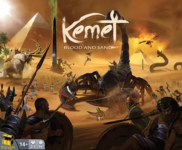
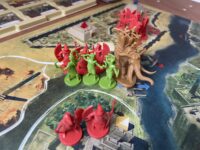
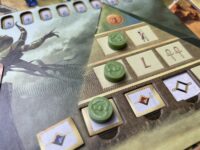

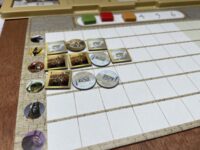
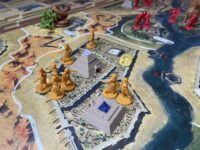
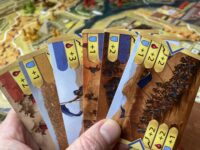


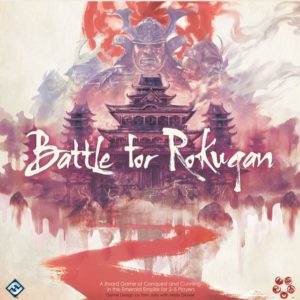

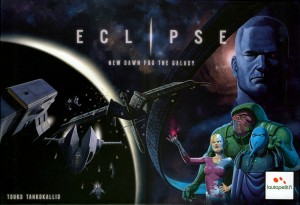
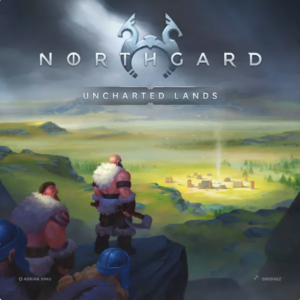
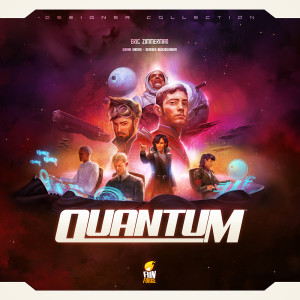
Sam says
I love a punch-up in a board game, so Kemet: Blood and Sand has a lot going for it in that respect. But I've no real love for miniatures - I like the instant readability of cubes and the tactility of wood - and for me, the huge number of Power tiles Blood and Sand makes available in every game (which rely on iconography and/or a reference rulebook for explanation) means to experience the game at anywhere near its best you need to play it regularly with the same players: so everyone knows what's going on, and the experience won't get bogged down in rules-referencing. And that wouldn't be so bad except whilst the power tile reference is clear, the rulebook for Blood and Sand is rather poor, making it a bit of a slog to learn in the first place. If you enjoy a real scrap, with a lot of leader-bashing, there's a good game beneath that opacity, but you need an invested group to get to that point, and one that likes the oddball mash-up of Egyptian setting plus giant scorpions. I enjoyed my visit well enough once things began to swim into focus, but I'd play any and all of the if-you-liked-this games on the right ahead of it.